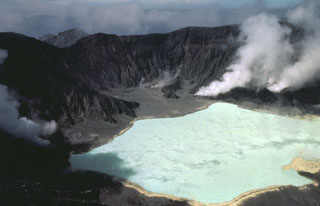Report on El Chichon (Mexico) — November 1990
Bulletin of the Global Volcanism Network, vol. 15, no. 11 (November 1990)
Managing Editor: Lindsay McClelland.
El Chichon (Mexico) Thermal activity continues; no seismicity or dome growth
Please cite this report as:
Global Volcanism Program, 1990. Report on El Chichon (Mexico) (McClelland, L., ed.). Bulletin of the Global Volcanism Network, 15:11. Smithsonian Institution. https://doi.org/10.5479/si.GVP.BGVN199011-341120
El Chichon
Mexico
17.3602°N, 93.2297°W; summit elev. 1150 m
All times are local (unless otherwise noted)
"Recent reports of increased activity at El Chichón motivated a visit to the region. Analysis of records from nearby seismic stations (the nearest at Ostoacán, 115 km NW) showed no increased seismicity. A helicopter flight over the volcano on 10 November allowed observation of hydrothermal activity that had increased from last year's levels. The crater lake, which in the last few years had shrunk to a small pond, had recovered to the level of November 1982, and hydrothermal activity was similar to that observed in January 1983 (as described in Casadevall and others, 1984). The greenish-yellow lake now covers most of the crater floor, and numerous small fumaroles release steam through and around it. This activity is probably a result of the increased rainfall that reached 3,829 mm in the area January-October, compared to 3,219 mm measured during the same period last year. This increase was particularly high in October 1990, when 1,069 mm of rain was reported, compared to 701 mm measured in October 1989. As expected, no evidence of the start of a dome growth episode has been detected."
Reference. Casadevall, T., de la Cruz-Reyna, S., Rose, W.I., Bagley, S., Finnegan, D.L., and Zoller, W.H., 1984, Crater lake and post-eruption hydrothermal activity, El Chichón Volcano, México: JVGR, v. 23, p. 169-191.
Geological Summary. El Chichón is a small trachyandesitic tuff cone and lava dome complex in an isolated part of the Chiapas region in SE México. Prior to 1982, this relatively unknown volcano was heavily forested and of no greater height than adjacent non-volcanic peaks. The largest dome, the former summit of the volcano, was constructed within a 1.6 x 2 km summit crater created about 220,000 years ago. Two other large craters are located on the SW and SE flanks; a lava dome fills the SW crater, and an older dome is located on the NW flank. More than ten large explosive eruptions have occurred since the mid-Holocene. The powerful 1982 explosive eruptions of high-sulfur, anhydrite-bearing magma destroyed the summit lava dome and were accompanied by pyroclastic flows and surges that devastated an area extending about 8 km around the volcano. The eruptions created a new 1-km-wide, 300-m-deep crater that now contains an acidic crater lake.
Information Contacts: S. de la Cruz-Reyna, UNAM.; Romeo León Vidal, CFE, Tuxtla Gutiérrez, Chiapas, México.

